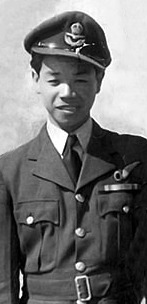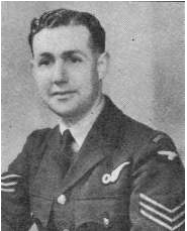EDWARDS, GEORGE MERCIER; Flight Sergeant (Air Gnr.); Service No. 1259259; Royal Air Force Volunteer Reserve; Age 24; Rear Gunner on Halifax B for Bertie (W7801).
George Edwards was born in Kingston, Jamaica, the son of George Henry Edwards & Sidona Edwards.
Military Service Sergeant Edwards was the Rear Gunner Halifax B for Bertie (W7801), one of two tug planes used during Operation Freshman. He was killed instantly when his aircraft crashed into Hæstad Mountain, Helleland, Norway, around midnight on the 19th November, 1942.
Sergeant Edwards is buried in the Commonwealth Grave plot in Helleland Churchyard, Norway.
OPERATION FRESHMAN
On the evening of November 19th, 1942, two Halifax bombers, each towing a Horsa Glider took off from RAF Skitten, near Wick in NE Scotland. On board each glider were 15 specially trained Royal Engineers, and two pilots. Their top-secret mission, code-named Operation Freshman, was to destroy the heavy water-producing facility at the Norsk Hydro industrial complex near Vemork, Norway. This facility was a crucial part of Nazi Germany’s efforts to develop a nuclear bomb.
Tragically, due to failures in the navigation and guidance systems and poor weather, the aircraft failed to identify the landing zones and were forced to turn back. During the return, extreme icing of the tow cables resulted in both gliders becoming detached from their tow-planes and they crashed in the mountains of SE Norway. In addition, one of the Halifax bombers also crashed, instantly killing all 7 crew members onboard, including Sergeant George Mercier Edwards from Kingston, Jamaica. The crew were initially buried in a shallow grave close to the crash site but were reinterred in the Commonwealth graves plot in Helleland Churchyard, Rogaland, Norway at the end of the war with full military honours.

Of the 34 men onboard the gliders, a number were killed on impact, while others were executed by firing squad shortly after their surrender at Slettebø, near Egersund. In addition, four, badly-injured soldiers were interrogated and murdered by the Gestapo in Stavanger, their bodies dumped at sea off the coast of Norway. At the end of the war, the remains of most of the soldiers were reinterred at the Commonwealth Grave section in Eiganes Cemetery in Stavanger, where a remembrance ceremony is held every year to honour their sacrifice.
Due to the secrecy surrounding the mission, very little information was provided to the families of the servicemen at the time, other than that they were missing. A short news article was published in a Norwegian newspaper shortly after the raid saying that a number of aircraft had landed in Norway and that all of the soldiers on board had been engaged and killed to the last man. However, it was not until after the war that true horror of the story emerged!
Over the years there have been a number of publications describing the events of Operation Freshman, and also the subsequent successful sabotage of the Vemork facility by British-trained Norwegian special forces soldiers (Operation Gunnerside). This action was immortalised in the Hollywood film The Heroes of Telemark, starring Kirk Douglas.
In 2011, Ion Drew’s excellent book, Silent Heroes, was published. In addition to the event itself, Silent Heroesalso provided a unique insight into the personal lives of the individual servicemen and their families, and contained information based on interviews, correspondence, and meetings with surviving relatives and ex-servicemen who had connections to the operation. At the time of publication, however, details of only some of the men were available. Efforts are now being made to address this gap as part of a project to update Silent Heroes. In particular, the project is looking for any additional information on Sergeant Edwards.
Ultimately the Operation Freshman Project is trying to trace surviving relatives or people who have stories or anecdotes concerning the servicemen who participated in the raid, and who may have photographs, letters or other documentary information relating to the servicemen. The idea is to tell the story of these incredibly courageous young men through their lives, and lives of their families, rather than more conventional histories which focus primarily on the events themselves.
[Source: Dr. Bruce A. Tocher]














 Promoting the Noble Heritage of Caribbean Air Crew who Served in Freedom's Cause in World War II - The Law Firm of Gabriel J Christian & Associates, LLC.
Promoting the Noble Heritage of Caribbean Air Crew who Served in Freedom's Cause in World War II - The Law Firm of Gabriel J Christian & Associates, LLC.